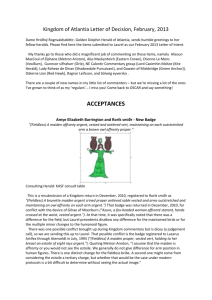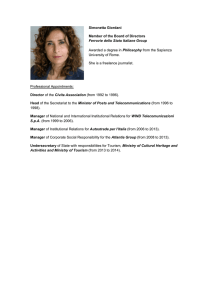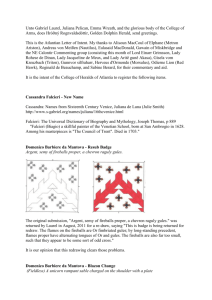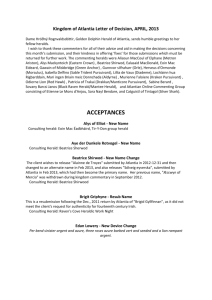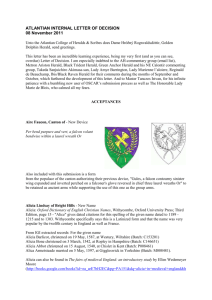Word - The Atlantian College of Heralds
advertisement
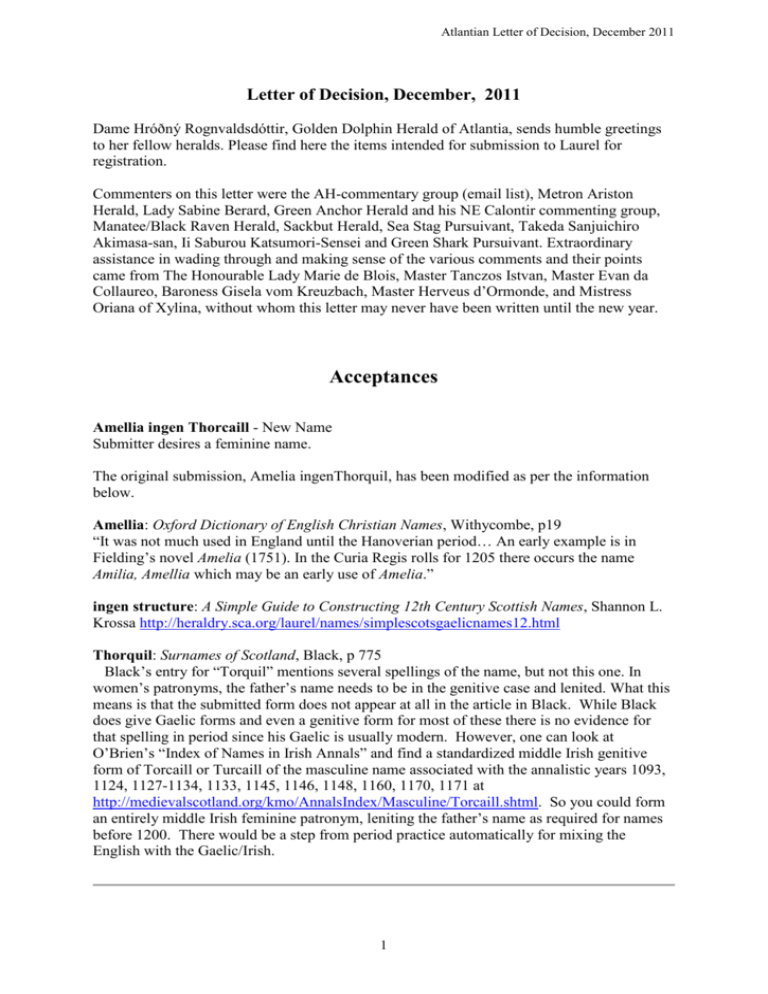
Atlantian Letter of Decision, December 2011
Letter of Decision, December, 2011
Dame Hróðný Rognvaldsdóttir, Golden Dolphin Herald of Atlantia, sends humble greetings
to her fellow heralds. Please find here the items intended for submission to Laurel for
registration.
Commenters on this letter were the AH-commentary group (email list), Metron Ariston
Herald, Lady Sabine Berard, Green Anchor Herald and his NE Calontir commenting group,
Manatee/Black Raven Herald, Sackbut Herald, Sea Stag Pursuivant, Takeda Sanjuichiro
Akimasa-san, Ii Saburou Katsumori-Sensei and Green Shark Pursuivant. Extraordinary
assistance in wading through and making sense of the various comments and their points
came from The Honourable Lady Marie de Blois, Master Tanczos Istvan, Master Evan da
Collaureo, Baroness Gisela vom Kreuzbach, Master Herveus d’Ormonde, and Mistress
Oriana of Xylina, without whom this letter may never have been written until the new year.
Acceptances
Amellia ingen Thorcaill - New Name
Submitter desires a feminine name.
The original submission, Amelia ingenThorquil, has been modified as per the information
below.
Amellia: Oxford Dictionary of English Christian Names, Withycombe, p19
“It was not much used in England until the Hanoverian period… An early example is in
Fielding’s novel Amelia (1751). In the Curia Regis rolls for 1205 there occurs the name
Amilia, Amellia which may be an early use of Amelia.”
ingen structure: A Simple Guide to Constructing 12th Century Scottish Names, Shannon L.
Krossa http://heraldry.sca.org/laurel/names/simplescotsgaelicnames12.html
Thorquil: Surnames of Scotland, Black, p 775
Black’s entry for “Torquil” mentions several spellings of the name, but not this one. In
women’s patronyms, the father’s name needs to be in the genitive case and lenited. What this
means is that the submitted form does not appear at all in the article in Black. While Black
does give Gaelic forms and even a genitive form for most of these there is no evidence for
that spelling in period since his Gaelic is usually modern. However, one can look at
O’Brien’s “Index of Names in Irish Annals” and find a standardized middle Irish genitive
form of Torcaill or Turcaill of the masculine name associated with the annalistic years 1093,
1124, 1127-1134, 1133, 1145, 1146, 1148, 1160, 1170, 1171 at
http://medievalscotland.org/kmo/AnnalsIndex/Masculine/Torcaill.shtml. So you could form
an entirely middle Irish feminine patronym, leniting the father’s name as required for names
before 1200. There would be a step from period practice automatically for mixing the
English with the Gaelic/Irish.
1
Atlantian Letter of Decision, December 2011
Armegaerdj Sigurdsdottir –
New Device
The name has been pended as of the
October, 2011 LoI.
Per bend sinister Or and azure, a
kraken inverted counterchanged
within a bordure sable
---------------------------------------------------------------------------------------------------------------Attilium, Canton of - New Badge
Name registered in December of 1982,
via Atlantia.
(Fieldless) a cross moline gules,
charged with a yak tail argent
The Canton appeals to the Grandfather clause, citing their (released) badge:
The following device associated with this name was registered in February of 1984 (via
Atlantia) and changed/released in September of 2002 (via Atlantia): Gules, a laurel wreath
and in chief four yak tails palewise argent.
Cailin Ruffo - New Name & New
Device
Purpure, in fess, a skull and sword
inverted palewise argent
Submitter desires a masculine name.
Cailin: Scottish Gaelic Given Names:
For Men: Names of Scottish Gaels
from Scottish Gaelic Sources,
Sharon Krossa
http://medievalscotland.org/scotnames/gaelicgiven/men/cailin.shtml
"The 1467 manuscript, a collection of genealogies of Scottish Gaelic families written in
Ireland by a Scottish Gael and dated 1467 A.D., gives the following spellings for forms of
Cailin (1467 MS): ... "cailin" "cailin" •a man in the 1st generation of the genealogy of Clann
Cailin (and so theoretically should be nominative case)... Note, however, that the first person
listed in a genealogy was not necessary alive at the time the genealogy was written in 1467 --
2
Atlantian Letter of Decision, December 2011
in some cases he may have been dead for many generations. Note also that the 1467 MS
tends towards archaic spellings."
(The article continues, and documents the name in use 1401-1500 and in 1501- 1600).
1529.11 (Connacht)
Mac Cailin .i. Cailin mac Gilla Espuic, enrogha a nOirir Ghaoidhelaib uile ar engnam & ar
oinec, mortuus est.
1529.11
Mac Cailin, Cailin son of Gilla Espuic, the favourite in all Argyle for his valour and
bounty, died."
Ruffo: Surnames of Scotland, Black, p 703, Heading: Ruffus "Donald Ruffo had a remission
in 1427 (Rose, p 126)"
There is one SFPP for mixing Gaelic Cailin with Scots Ruffo, which is allowable.
As for the device, prior precedent says (January 2010 LoAR):
Soshka Gregor'evich Vilanov. Badge. (Fieldless) A skull argent wearing a pearled coronet
Or.
......
The badge is not in conflict with the badge of Valentine Christian Warner, Purpure, a skull
argent wearing a fool's cap per pale ermine and Or. There is a CD for the fieldless design.
The hat in Valentine's badge was ruled to be half of the charge in the return of Fabio
Ventura's submission; therefore, there is a second CD for changing half the tincture of the
primary charge.
So, because Valentine's hat is half the charge, we believe this submission is clear of
Valentine’s. For purposes of this device, we count it as 1 CD for changing half the type of the
charge group and 1 CD for changing the arrangement of the charge group (in pale vs in fess).
(Valentine’s badge shown below.)
Colete le Sauvage - New Name
Submitter desires a feminine name.
Colete: An Index to the Given Names in the 1292 Census of Paris, Colm Dubh
http://heraldry.sca.org/laurel/names/paris.html , "Colete [une] fille"
3
Atlantian Letter of Decision, December 2011
le Sauvage: Dictionary of English Surnames, Reaney and Wilson, s.n. Savage, show several
instances of the byname derived from the Old French sauvage to support the use of the
article: William le Saluage dated to 1194, Robert le Sauuage from 1198 and Ralph le Savage
from 1268..
Darius of Brockore Abbey - New
Name & New Device
Per chevron purpure and sable, in pale a
scorpion and sword argent
Darius: In the Vulgate Bible, Daniel
5:30. See
http://www.latinvulgate.com/verse.asp
x?t=0&b=32&c=5.
Darius is the Latinized form not only
the name of several ancient Persian kings, but also the name of an early saint and martyr
whose feast day is December 19 (www.saintpatrickdc.org/ss/1219.htm#dari). While we were
unable to find a clear instance of the Latinized Darius as a byname in period, the saint’s name
would be usable as an unmarked patronymic in the eastern Empire and the Persian form
Daryush appears to be used as a surname at least in modern times, e.g., the poetess Elizabeth
Daryush (en.wikipedia.org/wiki/Elizabeth_Daryush)”.
Brockore Abbey, Canton of: branch name registered in August 2008 via Atlantia
Elianor Huxley - New Name
Submitter desires a feminine name. No major changes.
Sound (English 12th - 14th century) most important.
Elianor: Oxford Dictionary of English Christian Names, Withycombe, p 97
Header: Eleanor "Elianora FA 1303, 1346" Withycombe also says, “From the 12th to the
15th C the name usually appears as Alienor, Eleanor, Elianor.”
Huxley: Dictionary of English Surnames, Reaney & Wilson, p 246
Header: Huxley "William Huxley 1530 FFEss From Huxley (Ches.)"
Mari Sol de Cordoba – new name
No major changes
sound most important: “Maree Sol”
Mari: Spanish Names from the Late 15th Century, Juliana de Luna
http://heraldry.sca.org/laurel/names/isabella/WomensGivenAlpha.html , citing 11
occurrences
4
Atlantian Letter of Decision, December 2011
Sol: Jewish Women’s Names in 13th to 15th century Navarre, Julie Kahen
http://www.s-gabriel.org/names/juetta/navarra.html
Sol 'sun' : Sol 1173, 1284, 1285, 1309, 1319, 1328, 1342, 1353, 1365
de Cordoba: Spanish Names from the Late 15th Century, Juliana de Luna
http://heraldry.sca.org/laurel/names/isabella/locative.html
... de Corcoles
de Cordoba (also de Codova)
de Coria...
I owe an apology for this submission. It actually was on last month’s Letter of Decision but
the name was accidently included when the device had to be returned.
Morishima Aishiko - New Name &
New Device
Argent, *in cross* a rose proper
between four mullets of five points
voided and interlaced each mullet
within and conjoined to an annulet
purpure.
Submitter desires a feminine name.
Sound most important.
Spelling (Japanese forest island) most
important.
The construction has been changed from the submitted “Aishiko Morishima” to conform to
Japanese naming style.
Aishiko: submitter's legal middle name (copy of license attached to paperwork)
Morishima: client requests help from the College for this constructed byname.
Mori - Forest, shima island. There is a Shima penninsula
Mori - (Solveig's Pamphlet "under woods") - under "works of nature" meaning "uncertain"
dated to 1600 p 148
Shima is also a surname - under "works of nature", unknown meaning. Dated 1568 p 148
Japan, its history, arts and literature, Volume 8 By Frank Brinkley shows a potter named
Morishima c 1600AD on page 342 (no exact date is given, but he is the father of a master
potter who lived c 1647AD). It can be found at
http://books.google.com/books?id=LORKAQAAIAAJ&pg=PA342&dq=morishima+history
&hl=en#v=onepage&q=morishima&f=false
The device was reblazoned to reflect the co-primaries, and in view of a comment that Wreath
is currently working out a precedence for this stylist type, this will be sent up to Laurel for
ruling, even though, as Metron Ariston Herald points out, “ ...as for the device it will have to
be returned for using the voided and interlaced mullets in a peripheral portion of the device.
This is a precedent that has been applied fairly consistently of late. For example, in March,
5
Atlantian Letter of Decision, December 2011
2011, the device of Earnwulf Ælfgaressune (“Sable, on a pale between a mullet voided and
interlaced and a pair of scissors argent a feather azure.”) was returned with the comment
“This device is returned for using a charge voided which is not in the center of the design.
This is a violation of section VIII.3 of the Rules for Submissions, which requires that
“Voiding and fimbriation may only be used with simple geometric charges placed in the
center of the design.” I should also note that the blazon implies that you have a primary rose
with four secondary mullet-annulet conjunctions but the emblazon shows a group of five
primary round things in cross. This is important because it means that, as shown in the
emblazon, this must also be returned for using “slot machine heraldry” following the
precedent set in the cover letter for March, 2009, and reaffirmed in returning the device of
Nest verch Rodri ap Madyn (“Per bend sinister azure and vert, a mullet voided and interlaced
within and conjoined to an annulet argent and an open book Or.”) where it was noted that “In
this submission, the mullet, annulet, and book are considered to form a single primary charge
group on the field. Therefore, this device is returned for violating section VIII.1.a of the
Rules for Submissions, which says that “three or more types of charges should not be used in
the same group.””
Robin Archer Dragun - New Name
No major changes.
Sound (all name elements) most important.
Robin: Dictionary of Christian Names, Withycombe, p 254 under the header "Robert"
(Robin Cur 1200, 1205, 1210, Cl 1276)
Archer: Dictionary of English Surnames, Reaney & Wilson, p 13 under the header "Archer,
Larcher, L'Archer" (Afr "archer"), “Hugh le Archer dated to 1199”
Dragun: Dictionary of English Surnames, Reaney & Wilson, p 141 under the header
"Dragon" (Walter Dragun 1166)
Theodred aet Ravenesdale - New
Device & New Name
Argent, a ferret rampant azure, in
chief two mullets sable
Theodred: "Prosopography of AngloSaxon England" at
http://www.pase.ac.uk/index.html shows
16 incidents of the name;
Theodred 1: Man known to Bishop
Theodred 3
Theodred 2: (e viii) Man who took Willibald 4 to the monastery of Bishops Waltham, when he was
five years old
Theodred 3: (e ix) Bishop of London, 909x926-951x953; and of Elmham
Theodred 4: (l x) Bishop of Elmham, fl. 974-995
Theodred 5: (l xi) Brother of Evesham, fl. 1077
6
Atlantian Letter of Decision, December 2011
Theodred 6: (l xi) Brother of Bath, fl. 1077
Theodred 7: (m xi) Moneyer associated with the Buckingham mint for Edward 15 (1056-1059)
Theodred 8: (m xi) Moneyer associated with the Hastings mint for Edward 15 (1059-1066)
Theodred 9: (m xi) Moneyer associated with the Hastings mint for Harold 3 (1066-1066)
Theodred 10: (m xi) Moneyer associated with the Hertford mint for Edward 15 (1048-1050)
Theodred 11: (l x) Moneyer associated with the Lincoln mint for Æthelred 32 (991-997)
Theodred 12: (e xi-l x) Moneyer associated with the London mint for Æthelred 32 (1003-991)
Theodred 13: (e xi) Moneyer associated with the London mint for Cnut 3 (1023-1029)
Theodred 14: (m xi) Moneyer associated with the London mint for Edward 15 (1042-1046)
Theodred 15: (m x) Moneyer associated with an unspecified mint for Eadred 16 (946-955)
Theodred 16: (m x) Moneyer associated with an unspecified mint for Edmund 14 (939-946)
aet Ravenesdale: name found in the O&A under Coenred aet Ravenesdale, registered in January
2005. Client is the son of Coenred.
“The preposition is the standard preposition in Old English for at and takes the dative as noted in
Hall’s Concise Anglo-Saxon Dictionary (s.v. æt). The locative Rauenesdal appears in Ekwall
(Concise Oxford Dictionary of English Place-names, s.n. Ravensdale) dated to Domesday Book and
this would be the correct Old English dative form with the preposition.”
Þorviðr Brjansson - New Device
Name submitted via Atlantia, August
31, 2011.
Gules, on a pale potenty Or, a Thor's
hammer sable
Returns
Allessandra della Luna - New Badge
Name registered in may, 2009, via
Trimaris.
(Fieldless) In pale a dragon sejant
affronty wings displayed Or issuant
from a crescent argent
This is being returned for conflict with the August 31, 2011 submission via Atlantia of:
7
Atlantian Letter of Decision, December 2011
Christian Darmody - New Badge, (Fieldless) A cross crosslet fitchy Or and a crescent
argent in pale conjoined.
Attilium, Canton of - New Name Change
Old Item: Attillium, Canton of, to be released.
No changes.
“Name change is being submitted to make the official name spelling match the tax I.D.
spelling and bank accounts. A letter of populace support is provided.”
No action needs to be taken as the form “Attilium” – with one “l” - is what is what has been
registered in the O&A since December of 1982. Therefore, there is nothing to release.
Bersi Berserkr inn svartiulf - New
Name & New Device
Gules, a couped wolf’s head uluant to
dexter overall a roundel argent and a
chief checky sable and argent.
Submitter desires a masculine name.
Meaning most important.
Bersi: Geir Bassi, p 8
Berserkr: descriptive, Geirr Bassi p 20
in svartiulfr - construct byname, inn svarti - "Black" Geirr Bassi p 28
ulfr - "wolf"
Bersi is fine as a masculine given name. It appears on page 8 of The Old Norse Name where
it is shown as having 6 occurrences in the Landnámabók. The byname berserkr also appears
in the cited location in The Old Norse Name, but by longstanding Laurel precedent such
descriptive bynames must be entirely in lower case –“Bersi berserkr” . For the last elements
of the name, there is a Laurel precendence which disallows a [color] + [name] for bynames,
the last paragraph reads:
“Lacking solid evidence of a clear pattern of descriptive bynames of the form [color] +
[animal] in Old Norse, there is no support for the submitted Hvithestr as a plausible
descriptive byname in Old Norse.” (This precedent was set in the return of Kristin Hvithestr
in December, 2003.) If you drop the second byname entirely and make the first letter of the
byname lower case, you would have Bersi berserkr which appears to have no obvious
conflicts.
Since the name must be returned, so too must the device. That being the case, it would be
helpful to redraw the checky in the chief so it is in squares rather than rectangles.
8
Atlantian Letter of Decision, December 2011
Brigid Gyllfinnan - New Name
Submitter desires a feminine name.
Language most important.
Client requests authenticity for 14th century Irish.
Culture (Irish) most important.
Brigid (var): Oxford Dictionary of English Christian Names, Withycombe, p 54, under the HEADER:
Bridget “…Old Irish Brigit, later Brigid (modern Irish Brighid pronounced brī’ĭd).”
Gyllfinnan (variations of Giola-fionnain): Names and Naming Practises in the Red Book of Ormand
(Ireland 14th Century), Heather Rose
http://www.s-gabriel.org/names/tangwystyl/lateirish/ormond-given.html
The name is found there as a masculine given name. Since Irish doesn’t use unmarked patronyms, this
will have to be “inghean Gyllfinnan” (subject to the usual case change and lenition).
From Metron Ariston: Unfortunately, this name does not meet her request for authenticity for
fourteenth century Irish. If you go back and read the article from Withycombe used for
documentation of the given name, you will find that this spelling of the Irish saint’s name is not dated
to the fourteenth century or even dated at all. (The term “later” is vague and could be out of period.)
Unfortunately, O’Brien’s “Index of Names in Irish Annals” at
http://medievalscotland.org/kmo/AnnalsIndex/Feminine/Brigit.shtml indicates that the only person to
appear in the Annals with this name is the sixth century saint. Jones’ article cited for the byname (and
again you need to cite at least the main URL for that which is
http://heraldry.sca.org/laurel/names/lateirish/ormond.html) does not show any clear-cut form of
Brigid, though she does suggest that the documented Bridok might be “possibly a diminutive of
Brighid, along the lines of Brighiduc (unattested). No other language context available.”
Based on some playing with IGI, I can document the given name in the spelling Brigid but only in
an English context and only one of those is from before 1600: Brigid Reed married at Harrow on the
Hill on 16 November, 1560 (Batch M013291) .
It would be solid for an English context as there are quite a few instances from the grey area,
including Brigid Norwood christened at Milton by Gravesend in Kent on 28 February, 1601 (Batch
C135021), Brigid Smith married at Westmeston in Sussex on 9 May, 1613 (Batch M042881), etc. But
that is from sixteenth and seventeenth century England and not fourteenth century Ireland.
Moreover, Jones’ article does not appear to show the spelling Gyllfinnan or anything close to that.
Under the normalized Irish Giolla-Fionnáin which is the only name element from which this could be
derived, Jones notes only “O Gillinan 1; compare Woulfe p.374 (Mac Giolla Fhionnáin) or possibly
from an unattested double diminutive "Gilínán"? See Woulfe p.540f.” And that O Gillinan is not Irish
but rather anglicized Irish so even if you changed the name to Brigid O Gillinan, it would not meet the
authenticity request for fourteenth century Irish. And, if you turn to O’Brien’s “16th & 17th Century
Anglicized Irish Surnames from Woulfe”, you find that the later documented anglicized forms do not
at all resemble the submitted byname (and none appear to be unmarked!): M'Gillinnion, M'Elinnan,
M'Elynan, M'Linnen and M'Gullyneane. And, if you want to make the patronym actually early
modern Irish, which the request for authenticity would require, the changes are even bigger: inghean
Giolla Finnéin.
Cassandra di Falcieri - New Name
Submitter desires a feminine name.
Language most important.
Spelling (Cassandra Falcieri) most important.
No changes.
Culture most important.
Cassandra: Names from Sixteenth Century Venice, Juliana de Luna (Julie Smith)
http://www.s-gabriel.org/names/juliana/16thcvenice.html
9
Atlantian Letter of Decision, December 2011
Falcieri: The Universal Dictionary of Biography and Mythology, Joseph Thomas, p 889
(copy of page included with submission)
"Falcieri (Biagio) a skillful painter of the Venetian School, born at San Ambrogio in 1628.
Among his masterpieces is "The Council of Trent". Died in 1703."
Unfortunately, the name cannot be registered as constructed. While the documentation
supports the perfectly acceptable “Cassandra Falcieri”, lack of permission for major or minor
changes forces us to return this submission so it can be, if the submitter wishes, altered to
drop the ‘di’ in the middle.
Elizabet Walkere - New Device
The name was registered in April of
2010, via Atlantia.
Vert, on a pale argent, a badger
regardent proper, collared motley
gules and Or and a border embattled
sable
This is being returned as the sable border
violates the Rule of Tincture. There being no proper tincture for badgers at this time, it is suggested
that the submitter specify the colours of the beastie in their blazon. The original device submission
(“Argent, a badger rampant reguardant sable, marked Or, garbed in motley lozengy gules and Or.”)
was returned by Laurel in May, 2010, with the following comments, “This device is returned because
the creature was not recognizable to most commenters as a badger, violating section VII.7.a of the
Rules for Submissions, which says "Elements must be recognizable solely from their appearance."
This redrawing of the shape, in the opinion of the majority of the commenters, solves that. However,
the badger risks being returned for having the argent markings against the argent pale, even though
the striped markings are the salient identifying feature of the badger. To ease that difficulty, it is
suggested that the artwork found for a regardent badger on the device labelled “Hufflepuff” at
http://commons.wikimedia.org/wiki/Category:Badgers_in_heraldry might be useful since it assumes
the same position as this one. Just don’t tell anyone I suggested a Harry Potter reference.
Longley provided documentation for clothed creatures in period armory: Pastoureau,
Heraldry: An Introduction to a Noble Tradition, shows a 16th century Bavarian tombstone on page 62
which has the arms of the Wolflin family, depicting a wolf wearing a doublet. Similarly, the arms of
Trainer, 1605 (Siebmacher 212) show a wolf (fox? dog?) wearing a short doublet or robe. In that case,
though, the beast's full head, tail and lower legs (as well as the "wrists" of the forefeet) were fully
uncovered.”
Elspeth McLur - New Name & New
Badge
(Fieldless) A heart argent voided azure
Submitter desires a feminine name.
Sound most important.
10
Atlantian Letter of Decision, December 2011
Elspeth: A List of Feminine Personal Names Found in Scottish Records, Part I: Introduction, Talan
Gwynek (Brian Scott) under the heading:
Elizabeth 1467 [TOD, 773]; 1571 [SCAPA, 711] ...Elspet 1512 [DRUMBRECK, 222]; 1570
[RANKEN, 683]
McLur: A Dictionary of English Surnames, Reaney & Wilson, p 291
John McLur 1526 Black
Conflict with Elspeth MacClure, registered August 1979 via the West Kingdom (recorded in the
Heraldicon http://heraldry.sca.org/loar/1979/Heraldicon/acceptances.htm) , forces return of both name
and badge.
The badge would have been returned on its own, however, as the Laurel precedent forbidding
voiding charges on fieldless badges is still in place. From Master Baldwin’s precedents:
“If a charge can be considered a medium for heraldic display, it may not bear a tertiary in a
fieldless badge: such a design is interpretable as a display of arms, with the tertiary as a primary. For
instance, we don't permit (fieldless) On a lozenge argent a fleur-de-lys gules: since the lozenge is a
medium for heraldic display, this looks like a display of Argent, a fleur-de-lys gules. Such arms-badge
confusion is reason enough for return, even if the display in question doesn't conflict. In this case, the
triangle inverted must be considered such a medium, comparable to the escutcheon, lozenge, or
roundel. It may be considered either an early-style shield (Neubecker's Heraldry: Sources, Symbols
and Meanings, p.76), or a lance-pennon [returned for this reason and also because the armory
obtained by considering the badge displayed on a triangular shield was in conflict]. (Barony of
Dragonsspine, March, 1993, pg. 25)”
And from Master Da’ud’s precedents:
“As this could as easily (and not incorrectly) be blazoned {Fieldless} A heart sable fimbriated Or,
this still conflicts with ... Argent a heart sable ... . In addition, as a heart is demonstrably a standard
shape for the display of armory in period, this also conflicts with ... Gules a bordure Or, ... Sable a
bordure argent, and ... Sable a bordure Or, a label gules. In each case there is only one CD for the
change to the field, to the tincture of the bordure, or for removing the label, respectively. [1/94, p.15]”
Mad Davy de Iarsey - New Badge
Name registered in June, 2007, via
Atlantia.
(Fieldless) A heart sable
This must be returned for a conflict with:
Cinzia del Lupo; Argent, a heart fracted palewise sable, January 1999 via Meridies
Note http://heraldry.sca.org/laurel/precedents/elsbeth/armory.html, "[a seeblatt sable vs. a
heart fracted palewise sable] By current precedent there is not a CD between a heart and a
seeblatt, nor is there a CD for fracting a charge. [Þorkatla Bjarnardóttir, 09/00, R-Artemisia]"
As well as a conflict with: Rustique de Suard; registered in April of 1997 (via the Middle):
Gyronny purpure and argent, a heart sable. with 1 CD for the change in field.
11
Atlantian Letter of Decision, December 2011
Robin Archer Dragun - New Device
Per pale azure and vert, a dragon
sejant erect affronty wings displayed
maintaining in each hand a sword Or,
on a chief argent three arrowheads
sable
There was concern about the
maintained swords/daggers not being
in contrast with the wings of the
dragon, but since this has a complexity
count of nine; five tinctures (azure, vert, Or, argent and sable) and four types of charge
(dragon, swords, chief, arrowheads), it must be returned in any case.
Siobhan Morgunn - New Name
Siobhan: Index of Names in Irish Annals, Mari Elspeth nic Bryan Kathleen M. O'Brien)
http://medievalscotland.org/kmo/AnnalsIndex/Feminine/Siban.shtml , which documents 22
incidents of the use of the name, spanning from 1310-1600.
Morgunn: Surnames of Scotland, Black, p611 under the Header: MORGAN - "Pictish form
is Morgunn"
The standard form of the early modern Irish name has a marking over the last vowel:
Siobhán. And, as it appears in O’Brien’s “Index of Names in Irish Annals” it is associated
with annalistic years of 1310, 1370, 1371, 1383, 1411, 1427, 1428, 1464, 1467, 1489, 1490,
1507, 1511, 1525, 1529, 1535, 1542, 1544, 1553, 1565, 1576, 1583, 1587, 1598 and 1600.
Thus, the earliest date associated with it is 1310, which is well over the three century limit
from the latest evidence for Pictish culture (the ninth century being the latest date of that
culture) so that there is a step from period practice for diachronic incompatibility. Morgunn,
as spelled, was a given name rather than a surname. Documentation is needed to support the
use of it in this configuration. There may also be a second step from period practice for the
admixture of early modern Irish and Pictish as well, just as there is a step from period
practice for the admixture of early modern Irish and old or middle Irish.
Pends
Jana de Foresta - New Device
Name registered August, 2011, via
Atantia.
12
Atlantian Letter of Decision, December 2011
Per pale argent and gules, a coney courant guardant sable, transfixed by an arrow bendwise
sinister counterchanged
Pended for re-draw as there is concern that the arrow would be considered a maintained
charge rather than a sustained one or considered neither clearly maintained nor clearly
sustained. Making the shaft wider and the arrowhead slightly larger will alleviate that
problem.
Raven's Cove, barony of – Kingdom Resub Order Name & New
Badge
Order of the Crossed Dirks
(Fieldless) Two dirks in saltire argent, in chief a raven volant to
chief sable.
Raven's Cove, Stronghold of (April 1990 via Atlantia).
Name previously submitted: Order of the Dirk, via Atlantia, returned in Kingdom 21Sep2011
From Metron Herald: The submission history is incorrect and incomplete. It was sent out
from Atlantia in April, 2011, and returned by Laurel in July, 2011, with the following
comments: “This name is returned for conflict with the registered name The Dark Horde.
Horde and Order are both designators, so we are left to compare dark and dirk.
Precedent says that changing 25% of the letters is sufficient difference in appearance.
However, these two names are not different enough in sound, as only the vowel sound is
different. The element dirk is originally Scots, first attested in English in 1602. Period Scots
and grey period English spellings do not use the modern spelling; instead they use durk and
other spellings. These do not change the problem of sound between the names. The spelling
dirk would be allowed as it is the modern blazon term we use for the item (see the Cover
Letter, From Pelican: SCA Blazonry Terms in Order Names and Heraldic Titles, for more
details).” This would allow the use of dirk in the order name, but they have not provided any
evidence for the use of “crossed” as a modifier in this manner in period order names. The
only two order names using “crossed” are the Order of the Crossed Needles registered in
February, 1987, and the Order of the Crossed Swords registered in September, 1986, both of
which are something like two decades before our current standards for order names.
Name pended for supporting documentation, the badge pended for redraw.
Raven's Cove, Barony of - New Badge
Sable, a raven-headed prow reversed to
sinister Or.
This submission is to be associated with
Award of the Drakkar Prow
13
Atlantian Letter of Decision, December 2011
Raven's Cove, Stronghold of registered April 1990 via Atlantia.
Award of the Drakkar Prow registered July 2011 via Atlantia.
Pended for redraw, and to clear conflict with Sigmund the Wingfooted
(Fieldless) A drakkar's figurehead couped to sinister Or, maintaining a "dag" rune gules.
and (if this is not considered ‘reversed to sinister’, for conflict with;
Celesta Vianello, (Fieldless) A gondola prow Or.
and with Bjorn inn gauzki, Sable, in bend a compass star and a drakkar prow Or.
Raven's Cove, barony of - New
Badge
Or, a raven volant within a compass
sable
Raven's Cove, Stronghold of (April
1990 via Atlantia).
Order of Pelorus, registered July 2011
via Atlantia
RfS VII.a. Identification Requirement - Elements must be recognizable solely from their
appearance.
Any charge, line of partition, or field treatment used in Society armory must be identifiable,
in and of itself, without labels or excessive explanation. Elements not used in period armory
may be defined and accepted for Society use if they are readily distinguishable from elements
that are already in use. The compass star, defined in the Society as a mullet of four greater
and four lesser points, is immediately identifiable without confusion with other mullets or
estoiles once its definition is known.
In this case, the compass star is not identifiable. Also consider the Holy Roman Empire, reg.
12/94 via Laurel: “Or, an eagle displayed sable (sometimes crowned, sometimes also nimbed
Or)”. Important non-SCA arms. We see only one CD for the compass.
Raven's Cove, barony of - New Badge
(Fieldless) A St. Clements anchor Or
maintaining on the flukes two ravens
addorsed close sable.
This submission is to be associated with
Award of St. Clements Cross
Raven's Cove, Stronghold of registered
April 1990 via Atlantia.
Award of Saint Clements Cross, registered July 2011 via Atlantia.
14
Atlantian Letter of Decision, December 2011
This is being pended for reworking due to conflict with: Rhode Island and Providence Plantation,
State of: Azure, an anchor Or. ( Important non-SCA arms)
Raven's Cove, barony of - New Badge
Sable, a sea-monkey Or.
This submission is to be associated with
Award of the Sea Monkey
Raven's Cove, Stronghold of registered
April 1990 via Atlantia.
Award of the Sea Monkey registered July
2011 via Atlantia.
Pended for redraw.
Raven's Cove, barony of - New
Badge
Sable, a coil of rope Or.
This submission is to be associated
with Award of the Winkle, registered
July 2011via Atlantia.
Raven's Cove, Stronghold of
registered April 1990 via Atlantia.
Pended for redraw.
Raven's Cove, barony of - New
Badge.
Sable, a senmurv Or.
This submission is to be associated with
Order of the Senmurv, registered July
2011, via Atlantia.
Raven's Cove, Stronghold of registered
April 1990 via Atlantia.
Pended for redraw, and to clear conflict with Bahram the Resplendent, reg. 2/83 via An Tir: “Sable, a
senmurv within an annulet of roundels Or.”
15
Atlantian Letter of Decision, December 2011
Raven's Cove, barony of - New Badge
(Fieldless) Seven minnows sable, three and one and three.
This submission is to be associated with Award of the Black
Minnow, registered July, 2011 via Atlantia
Raven's Cove, Stronghold of (April 1990 via Atlantia).
Pended for redraw.
I remain, in service,
Hrothny
16
